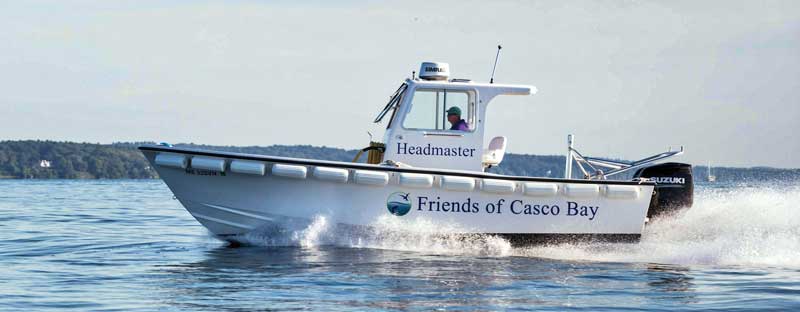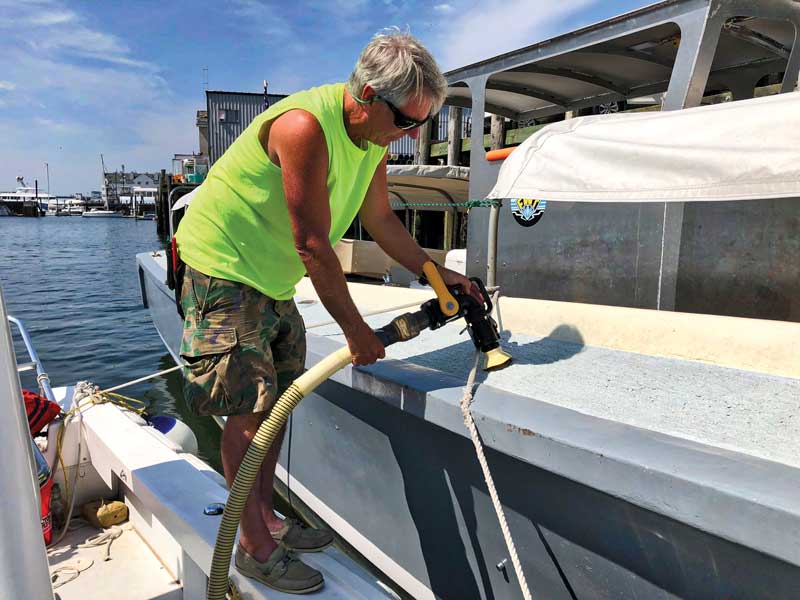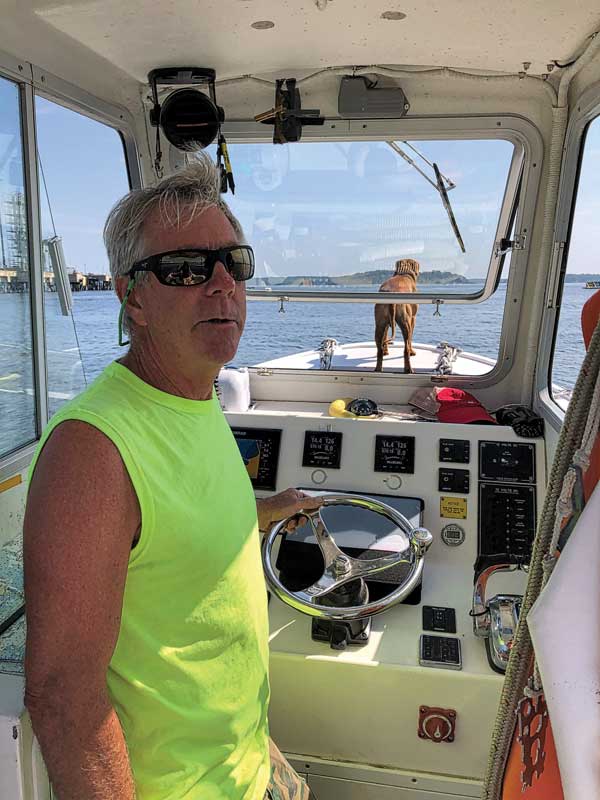 The Headmaster was launched in 2019 and has a 650-gallon waste-holding tank. Photo by Kevin Morris, courtesy of Friends of Casco Bay
The Headmaster was launched in 2019 and has a 650-gallon waste-holding tank. Photo by Kevin Morris, courtesy of Friends of Casco Bay
What better name than Headmaster for a boat that pumps sewage out of other vessels?
That’s exactly what the 26-foot Headmaster does as it collects and disposes of thousands of gallons of human waste each year from vessels large and small across Casco Bay.
As part of its mission to protect and improve the environmental health of Casco Bay, the Friends of Casco Bay organization has offered waste removal services to thousands of boats across the busy and expansive bay since it launched its first pump-out boat, the Wanda, in 1995. Its newest vessel, the Headmaster, was launched in 2019 and has a 650-gallon holding tank, more than double the size of the tank on the Wanda.
Combined, the two boats have pumped out more than 250,000 gallons of waste from vessels from South Portland to Harpswell. Rather than being discharged at sea, the waste is pumped into the Headmaster’s holding tank before being transferred to the Portland wastewater plant for treatment.
As captain of the Headmaster, Chris Gilday cruises around Casco Bay six days a week from mid-May through October, pumping out tour, charter, recreational, and other vessels at marinas, alongside piers, and at moorings.
 A former longtime commercial fisherman, Chris Gilday pumps out the holding tanks of vessels across Casco Bay from mid-May through October. Most of the boats are located from South Portland to Falmouth, but he will travel as far as Harpswell when needed. Photo by Clarke Canfield
A former longtime commercial fisherman, Chris Gilday pumps out the holding tanks of vessels across Casco Bay from mid-May through October. Most of the boats are located from South Portland to Falmouth, but he will travel as far as Harpswell when needed. Photo by Clarke Canfield
Gilday, a former longtime commercial fisherman, remembers the days when Portland Harbor and the bay were badly polluted. “I saw it with my own eyes; it was indisputable,” he said. Thanks to laws and a heightened awareness among the public, the waters are now relatively clean, serving as a draw for boaters of all types. Part of the cleanup, he says, is due to the 150-200 vessels that use the Friends of Casco Bay’s pump-out services to get rid of the poop, pee, and other wastewater from their holding tanks.
“If you make my sh__ list, you’re A-1,” he said with a laugh and his infectious smile. “You’re okay on my list.”
It’s no secret that Casco Bay used to be less than pristine, so much so that sailing magazines 50 years ago warned boaters to avoid the bay, said Will Everitt, executive director of Friends of Casco Bay.
Regulatory efforts—such as the federal Clean Water Act passed in 1972 and the federal government declaration of Casco Bay and other designated coastal waters as no-discharge zones—have had positive impacts, he said. The pump-out service allows boaters to make an individual impact on the health of the 230-square-mile bay, which supports recreation, tourism, commercial fishing, and shipping.
Altogether, there are just over 100 pump-out stations along the Maine coast from Kittery to Calais, according to the Maine Department of Environmental Protection. The vast majority are located at marinas, but there are also a handful of pump-out vessels: in Casco Bay, Quahog Bay, Boothbay Harbor, Camden Harbor, and Blue Hill Bay, according to the DEP.
As a no-discharge area, it is illegal to release raw or treated sewage from any vessel into Casco Bay; even peeing over the side of a boat is verboten. The organization’s pump-out service provides vessels in Casco Bay a simple way to remove their wastewater, comply with the law, and contribute to the environmental well-being of the ocean.
Boaters register for the service on the Friends’ website and pay the organization $10 for every 20 gallons of tank capacity. Ninety percent of the program is funded through the Maine Department of Environmental Protection’s pump-out grant program using federal grants aimed at helping fund pump-out programs throughout the state. In fact, all the pump-out stations in Maine receive funding from the program, according to a spokesman at the state agency.
 Chris Gilday is always accompanied by his dog, Edward, who likes to stand at the bow when the Headmaster is under way. Gilday recalls the days when boating magazines used to warn sailors to stay clear of Portland and Casco Bay because of pollution. Photo by Clarke Canfield
Chris Gilday is always accompanied by his dog, Edward, who likes to stand at the bow when the Headmaster is under way. Gilday recalls the days when boating magazines used to warn sailors to stay clear of Portland and Casco Bay because of pollution. Photo by Clarke Canfield
On a hot summer day, Gilday demonstrated how the service operates. His day starts at Breakwater Marina in South Portland, where the Headmaster is berthed next to the Joseph V. Payne, the Friends’ research vessel—named after Joe Payne, the longtime Casco Baykeeper who retired in 2015 after 24 years on the job. The current baykeeper, Ivy Frignoca, uses the vessel to monitor water quality, look into citizen concerns, and serve as an advocate for the health of the bay.
Gilday always brings his dog, Edward, a large and friendly Rhodesian ridgeback/Staffordshire terrier mix, who likes to stand at the bow while the boat is underway. The boat is powered by twin 250-hp Suzuki outboards, and Gilday appears as comfortable on the water as he is on land. He cut his teeth as a mariner while growing up on Long Island Sound, sailing out of the New York Athletic Club.
On this morning, he heads across Portland Harbor to the Portland waterfront, where he begins the day pumping the holding tanks of wooden charter sailboats that take tourists out for cruises throughout the day. His routine is to pull his boat alongside, grab a 60-foot flexible hose from his boat and attach it to a discharge valve from the below-deck holding tank on the other boat. Once the hose is in place, he turns on the Headmaster’s diaphragm pump, which pumps the untreated waste into a 650-gallon holding tank.
When the pump is first turned on and the sewage is pumped through, an unmistakable whiff of the waste releases into the air. Dealing with the smells is simply part of the job, Gilday said. The charter sailboats typically have holding tanks of 40-90 gallons, he said, and some of the private yachts hold more than 100 gallons. On the other end of the spectrum, he also pumps out tiny holding tanks.
“I do this one boat at Sunset Marina that’s a 21-foot Seaway with a holding tank that’s probably only two gallons,” he said. “I turn my pump on for 10 seconds and that’s it.”
As Gilday pulls up to his second boat of the day, the captain and crew of the Bagheera, a 72-foot gaff-rigged schooner that takes out tours each day, are on deck waiting. Their holding tank is nearly full and needs to be emptied before they start the day’s cruises.
Tripp Seaman, the vessel captain, said the Headmaster provides a vital service for the Bagheera and other vessels across the bay. Without it, “We would be forced to make a decision,” he said jokingly with a laugh, “to do something illegal or go very far away to get rid of our waste, which would cost us time and money. Time is money for us because we sail all day from 10:30 on.”
Through the day, Gilday goes from pier to pier and marina to marina, pumping out holding tanks from boats that have signed up for the service. He’ll service about 10 boats on a typical day. He also pumps out porta potties on Cow Island and the Nubble. The Headmaster weighs about 9,600 pounds when its holding tank is full—about double the weight of when it’s empty.
To get rid of the waste, he slowly motors into DiMillo’s Marina, which has a setup where Gilday can discharge what he’s collected into a system that feeds into the city of Portland’s sewage system. The waste then goes through the sewer system to the city’s wastewater plant, where it’s treated and eventually discharged back into the bay—clean and virtually pollution-free.
Gilday said he is proud to be affiliated with an organization whose purpose is to work toward the environmental well-being of the bay. In a typical year, the boat will collect 11,000-13,000 gallons of waste from vessels—waste that could otherwise end up in the ocean. “These guys are stewards,” he said, “and the proof is in the pudding.”
Clarke Canfield is a longtime journalist and author who has written and edited for newspapers, magazines, and The Associated Press. He lives in South Portland with his wife.
For More Information:
Friends of Casco Bay
43 Slocum Drive
South Portland, ME
207-799-8574






